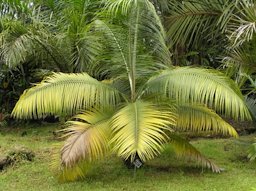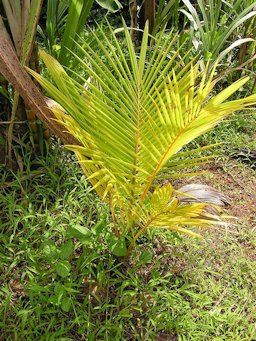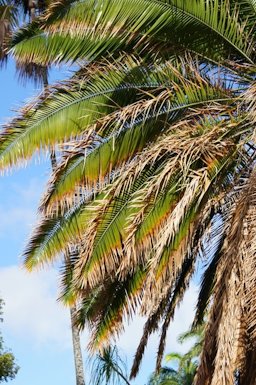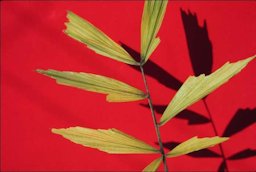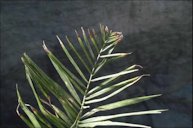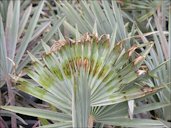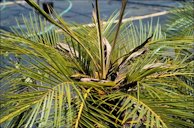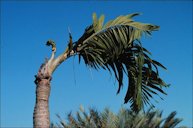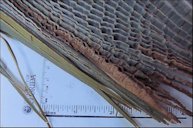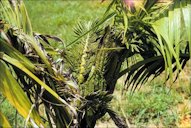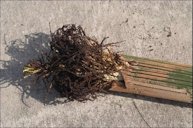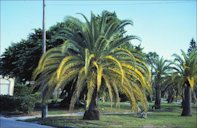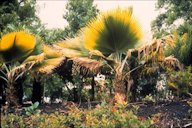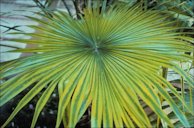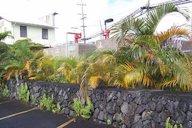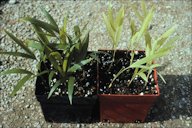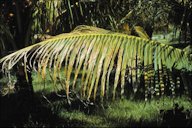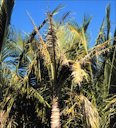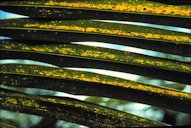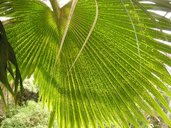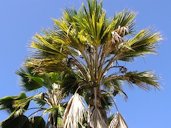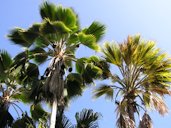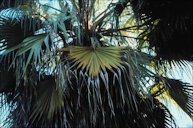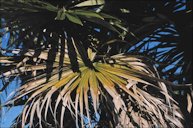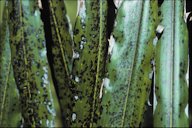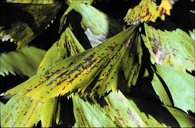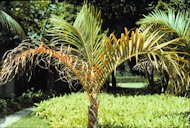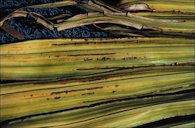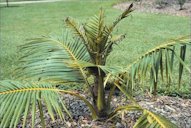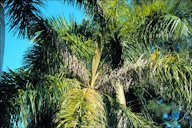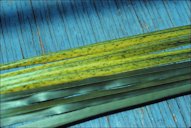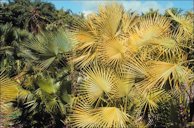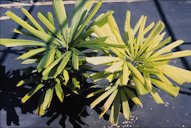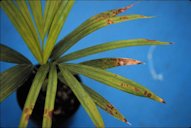| Nutrient Deficiencies in Palms | ||||||||||||||||||||||||||||||||||||||||||||||||||||||||||||||||||||||||||||||||||||||||||||||||||||||
|---|---|---|---|---|---|---|---|---|---|---|---|---|---|---|---|---|---|---|---|---|---|---|---|---|---|---|---|---|---|---|---|---|---|---|---|---|---|---|---|---|---|---|---|---|---|---|---|---|---|---|---|---|---|---|---|---|---|---|---|---|---|---|---|---|---|---|---|---|---|---|---|---|---|---|---|---|---|---|---|---|---|---|---|---|---|---|---|---|---|---|---|---|---|---|---|---|---|---|---|---|---|---|
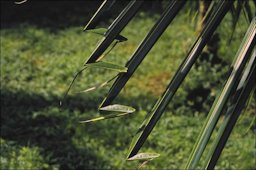 Fig.
1  Mild magnesium deficiency on coconut palm (C. nucifera)
 Nitrogen deficiency on coconut (C. nucifera)
 Potassium deficiency on coconut palm (C. nucifera), marginal necrosis
 Manganese deficient new leaf of Phoenix roebelenii showing longitudinal necrotic streaking
 New leaf of iron deficient Caryota mitis (clustering fishtail palm) seedling
|
Boron Deficiency (Fig.1)
In Cocos nucifera (coconut palm), mild B deficiency can be manifested as sharply bent leaflet tips, commonly called “hookleaf". These sharp leaflet hooks are quire rigid and cannot be straightened without tearing the leaflets. Boron deficiency can be very transient in nature, often affecting a developing leaf primordium for a very short period of time (e.g., 1 to 2 days). This temporary shortage of B can cause necrosis (dead tissue) on the primordial spear leaf for a distance of about 1 to 2 cm. When such leaves eventually expand, this “point” necrosis affects the tips of all leaflets intersected by that necrotic point, the net result being the appearance of a blunt, triangular truncation of the leaf tip (Fig. 2, 3). This pattern can be repeated as many as three times during the development of a single leaf of C. nucifera (about 5 weeks). 1
Fig. 2. Leaf tip of B-deficient Phoenix roebelenii (pygmy date palm) showing necrotic truncation in an inverted "V" shape Fig. 3. Boron deficiency of Bismarckia nobilis (Bismarck palm) showing necrosis at two separate times during the development of this leaf Fig. 4. Boron-deficient C. nucifera showing a series of inverted "V" shaped truncations on each leaf. These leaf constrictions represent separate temporary B deficiencies caused by a series of heavy rainfalls. Fig. 5. Multiple unopened spear leaves on a chronically B-deficient C. nucifera Fig. 6. Multiple unopened spear leaves on B-deficient P. roebelenii Fig. 7. Chronic B deficiency on Adonidia merrillii (Christmas palm) showing trunk bending. The tiny crumpled leaves indicate that the deficiency was at one time acute, but was subsequently alleviated to some degree. Fig. 8. Severe epinasty in Roystonea regia (Cuban royal palm) due to B deficiency. Note also the small size of some of the leaves Fig. 9. Bent new leaf of Syagrus romanzoffiana caused by B deficiency Fig. 10. Accordion-leaf in S. romanzoffiana, a symptom of B deficiency Fig. 11. Acute B deficiency in Heterospathe elata (sagisi palm) showing small crumpled new leaves Fig. 12. Necrotic inflorescence (flower stalk) of S. romanzoffiana caused by B deficiency Further Reading Boron Deficiency in Palms, University of Florida pdf (archived) Boron Deficiency in Palms in Hawai'i, University of Hawai'i at Mānoa pdf Magnesium Deficiency (Fig.13) Magnesium deficiency is caused by insufficient Mg in the soil. Magnesium is readily leached from sandy soils and other soils having little cation exchange capacity. High levels of, nitrogen (N), K, or calcium (Ca) in the soil can also induce or exacerbate Mg deficiencies. Magnesium deficiency is very common on highly leached soils in Florida, Hawai'i, and other tropical areas. It can also occur in container-grown palms if dolomitic limestone has not been added to the substrate. Also, since palms may remain in a container for up to a year or longer, any added dolomite is usually exhausted after six months or so with Mg deficiency symptoms becoming visible as a result. Most species of palms are susceptible to Mg deficiency to some degree, but Phoenix canariensis is by far the most susceptible species to this disorder. Magnesium (Mg)-deficiency appears on the oldest leaves of palms as broad chlorotic (yellow) bands along the margins with the central portion of the leaves remaining distinctly green (Fig. 14, 15). 2
Fig. 14. Magnesium deficiency (mid-canopy) and potassium deficiency (lower canopy) symptoms on Phoenix canariensis Fig. 15. Magnesium deficiency on Pritchardia sp. Fig. 16. A single old leaf of P. canariensis showing both K (tip) and Mg (base and middle) deficiency symptoms Fig. 17. P. canariensis showing both K (oldest leaves) and Mg (middle-aged leaves) deficiencies Fig. 18. Magnesium-deficient older leaf of Livistona rotundifolia showing yellow borders around individual leaflets Fig. 19. Magnesium deficiency on Areca Palms Further Reading Magnesium Deficiency in Palms, University of Florida pdf (archived) Nitrogen Deficiency (Fig.20) Nitrogen deficiency begins as a uniform light green discoloration of the oldest leaves (Fig. 21). As the deficiency progresses, younger leaves will also become discolored. When the entire crown except for the spear leaf is affected, leaves will become progressively lighter in color and may be nearly white (Fig. 22). Growth virtually stops when N deficiency is severe, but the palms may linger in this state for a considerable length of time. In older palms in the landscape or field, canopy size becomes greatly reduced, very light green in color, and the trunk will taper (pencil-pointing). 3
Fig. 21. Nitrogen deficieny on Ptychosperma elegans (solitaire palm) showing uniformly discolored older leaves Fig. 22. Nitrogen deficient Chamaedorea seifrizii (bamboo palm) seedlings on the right Fig. 23. Nitrogen deficiency on Palms Further Reading Nitrogen Deficiency in Palms, University of Florida pdf (archived) Potassium Deficiency (Fig.24) Visual symptoms alone may be sufficient for diagnosis of this disorder although leaf nutrient analysis may be helpful in distinguishing late stage K deficiency from manganese (Mn) deficiency. These two deficiencies can be extremely similar from a distance, but close examination should reveal characteristic spotting and marginal necrosis in K deficiency or necrotic streaking for Mn deficiency. Potassium deficiency symptoms are also more severe toward the leaf tip and are less so at the leaf base. The reverse is true for Mn deficiency.
Fig. 25, 26. Potassium deficiency on Coconut palm (C. nucifera), silver-leaf symptom Fig. 27. Potassium deficiency on Coconut palm (C. nucifera), marginal necrosis Fig. 28. Potassium-deficient older leaf of C. nucifera showing progression of symptoms from the base to the tip of the leaf Fig. 29. Late-stage K deficiency in C. nucifera showing small chlorotic and necrotic new leaves and trunk tapering. This palm died shortly after the photo was taken. Fig. 30. Potassium deficiency symptoms on older leaf of C. nucifera showing translucent yellow-orange spotting Fig. 31. Mild symptom leaf yellowing on Pritchardia palm Fig. 32. Mild symptom leaf speckling on Pritchardia palm Fig. 33. More severe symptoms and leaf dieback on Pritchardia palm Fig. 34,35. More severe symptoms and leaf dieback on Fan palm Fig. 36. Healthy and potassium deficient plants Fig. 37. Older K-deficient leaf of Dictyosperma album showing translucent yellow-orange spotting when held up to the light Fig. 38. Potassium-deficient older leaf of Dypsis cabadae showing necrosis and curling of leaflet tips Fig. 39. Potassium-deficient older leaf of Roystonea regia showing leaflet tip necrosis and curling Fig. 40. Potassium-deficient older leaf of Washingtonia robusta showing extensive leaflet tip necrosis Fig. 41. Potassium-deficient older leaf of Livistona chinensis showing leaf discoloration Fig. 42. Potassium deficiency of P. roebelenii Fig. 43. Potassium-deficient older leaf of Arenga sp. Fig. 44. Potassium-deficient older leaf of Caryota mitis Fig. 45. Potassium-deficient Hyophorbe verschafeltii showing the increase in severity of symptoms from new to old leaves Further Reading Potassium Deficiency in Palms, University of Florida pdf Potassium Deficiency of Palms in Hawai'i, University of Hawai'i at Mānoa pdf Manganese Deficiency (Fig.46) Manganese deficiency is caused by insufficient Mn in the soil or by high soil pH, which greatly reduces Mn availability. In soils where Mn is marginally sufficient, cold soil temperatures may cause temporary Mn deficiency by reducing root activity levels. This is particularly common on C. nucifera in Florida. The newest leaves of manganese (Mn)-deficient palms emerge chlorotic with longitudinal necrotic streaks (Fig. 47). As the deficiency progresses, newly emerging leaflets appear necrotic and withered on all but basal portions of the leaflets. This withering results in a curling of the leaflets about the rachis giving the leaf a frizzled appearance (“frizzletop”) (Fig. 49,50,51). Within a single leaf, Mn deficiency symptoms are concentrated at the base of the leaf and are less severe or nonexistent towards the tip (Fig. 52). On new leaves of Mn-deficient C. nucifera (coconut palm), necrotic leaflet tips fall off and the leaf has a singed appearance (Fig. 48). In severely Mn-deficient palms, growth stops and newly emerging leaves consist solely of necrotic petiole stubs. Palm death usually follows. 5
Fig. 47. Leaflets on youngest leaf of Mn-deficient Archontophoenix alexandrae (Alexandra palm). Note longitudinal necrotic streaking on chlorotic leaflets. Fig. 48. Manganese deficiency or "frizzletop" on Syagrus romanzoffiana caused by high soil pH. Note that old leaves are full size, while young leaves are greatly reduced in size. Fig. 49. Manganese deficiency on Roystonea regia (Cuban royal palm) Fig. 50. Manganese deficiency on P. roebelenii Fig. 51. Manganese deficiency or "frizzletop" of Acoelorrhaphe wrightii Fig. 52. New leaf of Mn-deficient A. alexandrae showing more severe symptoms towards the leaf base Fig. 53. Severe Mn deficiency in S. romanzoffiana Further Reading Manganese Deficiency in Palms, University of Florida pdf Iron Deficiency (Fig.54) Iron (Fe) deficiency appears as interveinal or uniform chlorosis of the newest leaves (Fig. 54). Older leaves remain green. In palms suffering from chronic Fe deficiency, the entire canopy may be chlorotic (Fig. 57 and 58). In severely Fe-deficient palms, new leaflets may have necrotic tips, growth will be stunted, and the meristem may eventually die (Fig. 55). 6
Fig. 55. Severe Fe deficiency on S. romanzoffiana seedling on left caused by poorly-aerated degraded potting substrate Fig. 56. Top leaflets are from the youngest leaf of an Fe-deficient S. romanzoffiana. Note diffuse green spots on otherwise chlorotic background. Lower leaflets are from an older leaf on the same palm. Iron deficiency is usually not caused by a lack of Fe in the soil, but rather by poor soil aeration or by planting palms too deeply (Fig. 57,58). Both factors reduce root respiration and therefore active uptake of Fe. Root injury from root rot diseases will similarly be expressed above ground as Fe deficiency, since the root surface area available for interception and uptake of Fe will be greatly reduced in root rotted palms. High soil pH is the most common cause of Fe deficiency in broadleaf trees and shrubs, but in palms it usually does not cause Fe deficiencies. Excessive uptake of other nutrient ions such as ammonium, phosphate, manganese, zinc, copper, and other heavy metals often results in Fe deficiency symptoms being expressed. 6
Fig. 57. Chronic Fe deficiency in Acoelorrhaphe wrightii (paurotis palm) on right caused by deep planting Fig. 58. Chronic Fe deficiency on Licuala spinosa caused by poorly aerated decomposed potting substrate Fig. 59. Iron toxicity on D. lutescens (areca palm) seedling showing necrotic spotting on the foliage Further Reading Iron Deficiency in Palms, University of Florida pdf Further Reading Normal Abnormalities in Palms, University of Florida pdf Physiological Disorders Palms, University of Florida pdf |
|||||||||||||||||||||||||||||||||||||||||||||||||||||||||||||||||||||||||||||||||||||||||||||||||||||
| Bibliography
1 Broschat, Timothy K. "Boron Deficiency in Palms." Environmental Horticulture, UF/IFAS Extension, ENH1012, Original Pub. Sept. 2005, Rev. June 2011 and May 2014, Reviewed Feb 2017, AskIFAS, Archived, edis.ifas.ufl.edu. Accessed 25 Apr. 2017, 10 Mar. 2024. 2 Broschat, Timothy K. "Magnesium Deficiency in Palms." Environmental Horticulture, UF/IFAS Extension, ENH 1014, Original Pub. Sept. 2005, Reviewed Apr. 2020, AskIFAS, Archived, edis.ifas.ufl.edu. Accessed 25 Apr. 2017, 10 Mar. 2024. 3 Broschat, Timothy K. "Nitrogen Deficiency in Palms." Environmental Horticulture, UF/IFAS Extension, ENH1016, Original Pub. Sept. 2005, Rev. May 2014, Reviewed Feb. 2017, AskIFAS, Archived, edis.ifas.ufl.edu//ep268. Accessed 25 Apr. 2017, 10 Mar. 2024. 4 Broschat, Timothy K. "Potassium Deficiency in Palms." Environmental Horticulture, UF/IFAS Extension, ENH1017, Original Pub. Sept. 2005, Rev. May 2011, Reviewed Apr. 2020, AskIFAS, Archived, edis.ifas.ufl.edu/ep269. Accessed 25 Apr. 2017, 10 Mar. 2024. 5 Broschat, Timothy K. "Manganese Deficiency in Palms." Environmental Horticulture, UF/IFAS Extension, ENH1015, Original Pub. Sept. 2005, Reviewed Feb. 2017, AskIFAS, edis.ifas.ufl.edu/ep267. Accessed 25 Apr. 2017, 10 Mar. 2024. 6 Broschat, Timothy K. "Iron Deficiency in Palms." Environmental Horticulture, UF/IFAS Extension, ENH1013, Original Pub. Aug. 2005, Rev. Sept. 2021, AskIFAS, edis.ifas.ufl.edu/EP265. Accessed 25 Apr. 2017, 13 Mar. 2019, 21 Jan. 2024. Photographs Fig. 1,2,3,4,5,6,7,8,9,10,11,12 Broschat, Timothy K. "Boron Deficiency in Palms." Environmental Horticulture, UF/IFAS Extension, AskIFAS, edis.ifas.ufl.edu. Accessed 7 May 2014. Fig. 13,19 Nelson, Scot C. "Magnesium Deficiency in Palms." Hawaii Plant Diseases, hawaiiplantdisease.net. Accessed 7 May 2014. Fig. 14,15,16,17,18 "Magnesium Deficiency in Palms." Environmental Horticulture, UF/IFAS Extension, AskIFAS, edis.ifas.ufl.edu. Accessed 7 May 2014. Fig. 20,23 Nelson, Scot C. "Nitrogen Deficiency in Palms." Hawaii Plant Diseases, hawaiiplantdisease.net. Accessed 5 May 2014. Fig. 21,22 "Nitrogen Deficiency in Palms." Environmental Horticulture, UF/IFAS Extension, AskIFAS, edis.ifas.ufl.edu. Accessed 7 May 2014. Fig. 24,25,26,27,31,31,33,34,35,36 Nelson, Scot C. "Potassium Deficiency." Hawaii Plant Diseases, hawaiiplantdisease.net. Accessed 7 May 2014. Fig. 28,29,30,37,38,39,40,41,42,43,44,45,46,47,48,49 "Potassium Deficiency." Environmental Horticulture, UF/IFAS Extension, AskIFAS, edis.ifas.ufl.edu. Accessed 7 May 2014. Fig. 54,55,56,57,58,59 Broschat, Timothy K. "Potassium Deficiency." Environmental Horticulture, UF/IFAS Extension, AskIFAS, edis.ifas.ufl.edu. Accessed 9 May 2014. Published 7 May 2014 LR. Last update 10 Mar. 2024 LR |
||||||||||||||||||||||||||||||||||||||||||||||||||||||||||||||||||||||||||||||||||||||||||||||||||||||
